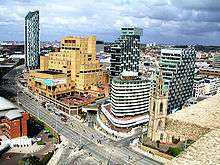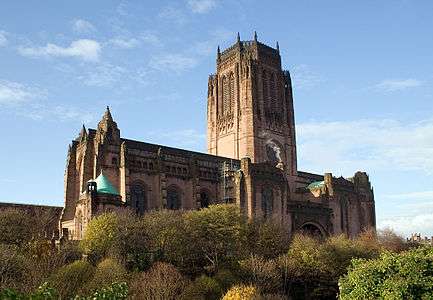Queensway Tunnel
.jpg) The Liverpool Entrance to the Queensway Tunnel | |
| Overview | |
|---|---|
| Location | Merseyside, England |
| Status | Active |
| Route | Queens Way |
| Start | Liverpool, Merseyside |
| End | Birkenhead, Merseyside |
| Operation | |
| Constructed | 1925–1934 |
| Opened | 18 July 1934 |
| Owner | Merseytravel |
| Traffic | Automotive |
| Toll | £1.80 for a car |
| Technical | |
| No. of lanes | 4 (2 northbound, 2 southbound) |
The Queensway Tunnel is a road tunnel under the River Mersey, in the north west of England, between Liverpool and Birkenhead. Locally, it is often referred to as the Birkenhead Tunnel or Old Tunnel, to distinguish it from the newer Kingsway Tunnel (1971), which serves Wallasey and the M53 motorway traffic.
History
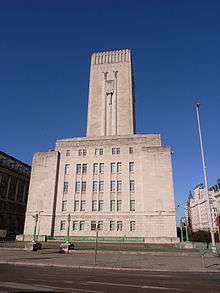
The first tunnel under the River Mersey was for the Mersey Railway in 1886. The first tunnel crossing was proposed in 1825, and again in 1827. A report in 1830 rejected the road tunnel due to concerns about building damage.
During the 1920s there were concerns about the long queues of cars and lorries at the Mersey Ferry terminal so once Royal Assent to a Parliamentary Bill was received construction of the first Mersey Road Tunnel started in 1925, to a design by consulting engineer Sir Basil Mott. Mott supervised the construction in association with John Brodie, who, as City Engineer of Liverpool, had co-ordinated the feasibility studies made by consultant Engineers Mott, Hay and Anderson. The main contractor was Edmund Nuttall.[1] In 1928 the two pilot tunnels met to within less than 25 millimetres (1.0 in).
The tunnel entrances, toll booths and ventilation building exteriors were designed by architect Herbert James Rowse, who is frequently but incorrectly credited with the whole civil engineering project. Their decoration is by Edmund Thompson.[2] These are Grade II listed buildings. More than 1.2 million tons of rock, gravel, and clay were excavated; some of it was used to build Otterspool Promenade. Of the 1,700 men who worked on the tunnel during the nine years of its construction, 17 were killed.
At the time of its opening it was the longest road tunnel in the world, a title it held for 14 years until the opening of the Vielha Tunnel in Catalonia, Spain in 1948, though it remained the longest underwater tunnel as of 1955.[3] The tunnel, which cost a total of £8 million, was opened on 18 July 1934 by King George V; the opening ceremony was watched by 200,000 people.[4]
By the 1960s, traffic volume had increased, and, in 1971, the Kingsway Tunnel opened to relieve congestion.
Description
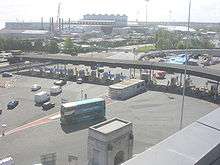
The tunnel is 3.24 kilometres (2.01 mi) long. It contains a single carriageway of four lanes, two in each direction. Different height restrictions apply to the nearside and offside lanes in each direction, because of the curvature of the tunnel. These are 3.9 metres (13 ft) and 4.75 metres (15.6 ft) respectively, and there is a 3.5 t weight limit for goods vehicles. All buses are required to use the offside lane, regardless of their height.
Lane signals (consisting of an illuminated green arrow or red cross) are displayed at regular intervals, although in normal circumstances none of the lanes are currently used bidirectionally. This is in contrast to the Kingsway Tunnel, where lanes in toll concourse are alternated to prioritise higher traffic in one direction during peak hours.
The tunnel has two branches leading off the main tunnel to the dock areas on both sides of the river. The Birkenhead branch tunnel (known as the Rendel Street branch) was closed in 1965. When travelling in the Birkenhead direction, the branch can still be seen inside the tunnel on the right just before the left hand bend towards the Birkenhead exit. The exit of this branch can also be seen on the outside from Rendell Street near the junction with Marcus Street, just north of Cleveland Street in Birkenhead. This branch also carried 2 way traffic, single lane each way. It was also controlled by traffic lights inside the tunnel. This branch mainly served Birkenhead docks and for people travelling to the Wirral resort of New Brighton. These are now best served by the Kingsway tunnel. The Liverpool branch tunnel remains in use, in the exit direction only. It emerges opposite the Liver Building, next to the Atlantic Tower Hotel and Church of Our Lady and Saint Nicholas. Originally, it carried two-way traffic and the junction inside the tunnel was controlled by traffic lights, but this arrangement was discontinued to reduce the delays brought on by increasing traffic levels.
The lighting inside the tunnel was updated in 1981 to replace the amber fluroescent tubes on the walls of the tunnel. The reason given for the change was that the old lighting was ineffective and inefficient. It also caused a flicker effect on vehicle windscreens, which could induce epileptic reactions in susceptible people.
Tolls
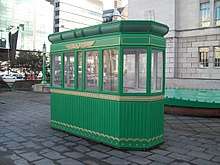
Tolls have been a feature of tunnel use since the Queensway Tunnel opened in 1933. Although residents were originally told tolls would be removed when debts were repaid, this position was dropped long ago. Debts and tolls were increased when the Kingsway Tunnel was built in 1971 to relieve congestion in the first tunnel. The County of Merseyside Act 1980 enshrined in law the right to continue collecting tolls once the debts were repaid. The later 2004 Act created a legal position where tolls charged must rise in line with the Retail Price Index (RPI) as published in November.[5]
Today
In April 2004 construction began of seven emergency refuges below the road deck, each capable of holding 180 people, as part of a £9 million project to bring the tunnel into line with the highest European safety standards. Each refuge is 21 metres (69 ft) long and 3 metres (9.8 ft) wide, accessible from the main tunnel walls. The refuges have fire resistant doors, ramps for wheelchair access, a supply of bottled water, a toilet, and a video link to the Mersey Tunnels Police control room. All seven refuges are linked by a walkway below the road surface, with exits at the Liverpool and Birkenhead ends.
In September 2009, a scene from Harry Potter and the Deathly Hallows – Part 1 set in the Dartford Crossing was filmed in Queensway tunnel, where Harry skips on a bus while on Hagrid's enchanted motorbike was filmed in the tunnel. In 2012 the tunnel was used for the filming of a chase scene for Fast & Furious 6.[6]
In 2012 the tunnel was refurbished, with 5999 added panels – ceramic steel cladding replacing the old plastic corrugated wall cladding to improve lighting and to give the Tunnel a 21st Century look.[7]
As of April 2018 the toll is £1.80 per journey[8] for a single passenger car of typical size, with progressively higher tolls for larger vehicles; solo motorcycles are free.[8] Average daily traffic through the tunnel currently stands at 35,000 vehicles, which equates to just under 12.8 million per year.[9]
See also
References
- ↑ Elson, Peter (9 August 2007). "Sir Nicholas Nuttall". Liverpool Daily Post. Archived from the original on 23 November 2008.
- ↑ "Port Sunlight 2". Antiques Roadshow. Series 35. Episode 3. 21 October 2012. BBC. Retrieved 21 October 2012.
- ↑ Guinness World Records 2015 (British ed.). The Jim Pattison Group. p. 184. ISBN 978-1-908843-62-3.
- ↑ "Queensway Tunnel". BBC. Retrieved 24 April 2016.
- ↑ http://www.liverpoolecho.co.uk/news/liverpool-news/mersey-tunnels-still-owe-58m-3324486
- ↑ Miles, Tina (8 May 2013). "Liverpool gets Fast and Furious film location boost". liverpoolecho. Retrieved 22 December 2017.
- ↑ Weston, Alan (28 Jan 2012). "Artwork incorporated in Mersey Tunnel refurbishment". Liverpool Echo. Retrieved 19 July 2014.
- 1 2 "Tolls, Fees and Charges". Mersey Tunnels. Retrieved 5 April 2018.
- ↑ Weston, Alan (4 December 2010). "Harry Potter film tour for Liverpool Queensway tunnel after Deathly Hallows filming". Liverpool Echo. Retrieved 22 November 2015.
Further reading
| Wikimedia Commons has media related to Queensway Tunnel. |
- Moore, Jim (1998) Underground Liverpool, Liverpool : Bluecoat Press, ISBN 1-872568-43-2
External links
Coordinates: 53°24′03″N 3°00′11″W / 53.4009°N 3.0031°W
| Next crossing upstream | River Mersey | Next crossing downstream |
| Mersey Railway Tunnel | Queensway Tunnel | Kingsway Tunnel |
| Records | ||
|---|---|---|
| Preceded by |
World's longest road tunnel 1934-1948 |
Succeeded by Vielha Tunnel 5.23 km (3.25 mi) |
